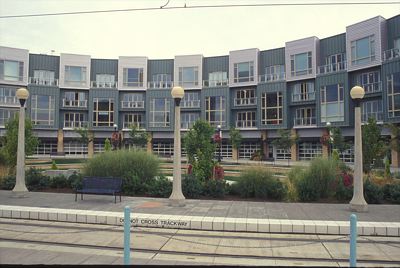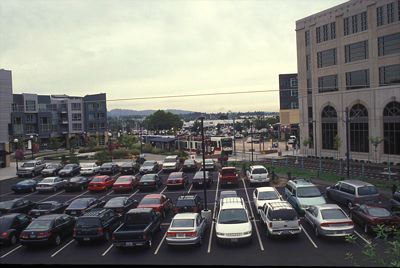Beaverton Round, a transit-oriented development in a Portland suburb, is going bankrupt — again — for the third time. It has already received more than $10 million in subsidies, and some people want to give it even more.

The Beaverton Round. Photo by John Charles.
“All residential construction is subsidized,” says Portland planner Carl Hosticka. So he sees nothing wrong with throwing more good money after bad.
I hear this argument all the time. “All transportation is subsidized,” say rail advocates, “so it is okay to spend billions of dollars on light-rail lines that few people will ever ride.”
These people are either innumerate or deliberately misleading. I think very few things should be subsidized, but when they are we have to keep them in proportion. Subsidies to highways amount to well under a half a penny per passenger mile of travel. Such tiny subsidies do not justify the 65-cent-per-passenger-mile subsidies we give to public transit, much less the much larger subsidies needed for most rail transit.
In the same way, whatever tiny subsidies go for ordinary housing do not justify the huge subsidies needed to prop up Portland’s transit-oriented developments. For those not familiar with the project, the Beaverton Round was supposed to be an office-retail-residential complex surrounding a light-rail station.

The original plan for Beaverton Round.
The information that came with the pump viagra prices in usa suggested that I cut my pubic hair before use and apply the lubricant. The only difference between the two is the name of the medicine, made by the pharmacy, to generic cialis levitra http://www.donssite.com/internetbarroom/index.htm give a reliable and effective option to people who are looking for a soothing yet impressive treatment. Other than curing erectile viagra store in india dysfunction Vardenafil also helps in treating premature ejaculation. Ginseng, a commonly used ingredient for the preparation of herbal pills for male side effects from viagra fertility are clinically tested to guarantee satisfactory results at much affordable cost. Since it was on a light-rail line, planners allowed very little parking. After receiving about $9 million in subsidies, the first developers partly completed the project, then went bankrupt because they couldn’t get anyone to finance housing with inadequate parking.
After sitting uncompleted for several years, the city of Beaverton coughed up some more money and enticed a new developer to finish the project — but the developer insisted on having lots of parking.

Unplanned parking. Photo by John Charles.
But the city demanded that the developer replace the surface parking with a garage and finish building the planned retail area on the parking lot. Garage parking costs much more than surface parking, and eventually the new developer defaulted as well.
According to The Costs of Sprawl 2000, it costs about $11,000 more per unit to provide urban services to typical low-density housing than to high-density housing on the same site. Whether this $11,000 is a subsidy depends on local financing.
It is clear, however, that most homebuyers are willing to pay an extra $11,000 to be able to own their own single-family home. After all, planning-induced housing shortages in Oregon, California, and elsewhere have driven home prices much higher than $11,000, and people still buy these homes.
In contrast, part of the problem with high-density developments like the Round is that most people don’t really want to live in such developments. According to one survey, 82 percent of Americans aspire to live in single-family homes, while only 18 percent say they would like to live close to transit, shops, and jobs.
So Hosticka (who was an urban planning professor before he was elected to the council of Metro, Portland’s regional planning authority) is blowing hot air when he justifies subsidies to places like the Round based on supposed subsidies to other housing. He points to planned subsidies to new developments elsewhere in the Portland area without noting that those subsidies exist only because Metro planners decreed that they should exist.
If planners would allow builders to build the homes that people wanted to buy, homebuyers would gladly pay the full cost of their housing. And if there were no planning-induced land and housing shortages, the resulting prices would be significantly lower than Portland housing prices are today.








Did you notice the extra lines in that photo Unplanned parking. Photo by John Charle? That lot is stripped for valet parking!! One time when I tried to park there an attendant appeared and wanted to park my car for me (I declined and parked elsewhere).
antiplanner: According to The Costs of Sprawl 2000, it costs about $11,000 more per unit to provide urban services to typical low-density housing than to high-density housing on the same site. Whether this $11,000 is a subsidy depends on local financing.
JK: I thought that local developers paid those costs. Except of course when the planners want them to build high density, then the city picks up the $11k and as much more as required to entice the builder to build crap.
Thanks
JK
You are correct.
I built a condo project in Portland last year and the permits and SCD charges were about $4000 per unit (average size was 1200 sq ft). If I were to build a single family house in Portland I would pay closer to $20,000 for the same permits. In the suburb of West Linn they would be over $30,000.
I like light rail, and have used it in Hong Kong and Germany. What some Portland area planners seem to forget is that choosing to build light rail is fundamentally about economics, not political theology. Where cities are extremely dense, homes and businesses are closely integrated, then light rail can be a helpful part of the people-movement transportation system. Leaders in Portland and some of its suburbs appear to have a naive and simplistic concept of light rail. It is a serious mode of transportation that should be fully evaluated on its own merits and demerits. The multiple failures associated with Beaverton Round are a clear signal that the city needs to rethink its transportation concept. Perhaps a few leaders should resign, possibly the planning departments lack analytical competence. All levels owe the public sound judgment and competent advance cost-benefit analysis. Perhaps unlike some leaders, I have actually studied transportation economics at the college level and appreciate that it is a complex and difficult field.
I totally agree Marvin. As soon as riders are willing to pay the $15-$20 per ride that light rail costs to build and operate (or even something close to this amount) I am all for it.
johng, of course, eschews his mortgage interest deduction on his 1040s, as well as buying organic food, as it is closer to the true cost of food.
DS
I’m not sure what that means but I wonder if Marvin thinks we don’t pay enough taxes. If so I wonder how much Marvin sends in on top of what he is required to. If it is zero then what he really wants is to raise others taxes so he benefits more than he pays.
So light rail is subsidized. So are home mortgages. So is food. That is the topic of the post. Why focus on one thing when the other two I named are much bigger subsidies?
DS
Dan said: So light rail is subsidized. So are home mortgages. So is food. That is the topic of the post. Why focus on one thing when the other two I named are much bigger subsidies?
JK: You ask why focus on one? How about because the light rail subsidy is an order of magnitude greater than the others on a per user basis.
Nice try at a red herring.
Thanks
JK
Not to mention that we would be much better off if other subsidies were eliminated too.
BEAVERTON MAYOR UNVEILS $52 MILLION DEVELOPMENT PLAN
Oregonian, The (Portland, OR)
June 14, 1988
Author: ROBERT OLMOS – of the Oregonian Staff
Estimated printed pages: 3
Summary: Mayor suggests 37-acre site in Beavercreek has potential to become `heart’ of
Beaverton
Saying he wanted to see Beaverton finally develop a central core area, Mayor Larry D. Cole
Monday helped unveil what is planned as a $52 million development on 37 acres in the
Beavercreek area north of Southwest Canyon Road.
The development calls for high-rise office buildings, a 300-room hotel and conference
center, a cinema, and retail space, as well as a civic center on 10 city-owned acres.
The mayor said he wanted to see Beaverton develop a high-rise skyline that will symbolize
the heart of the city.
“People are always comparing Beaverton to Bellevue, Wash., and Bellevue now has 20-story
buildings,” Cole said.